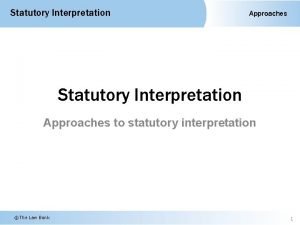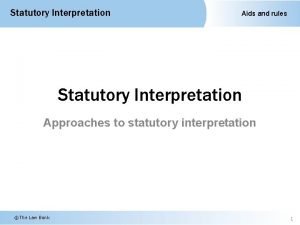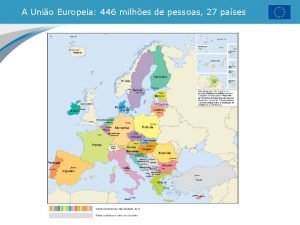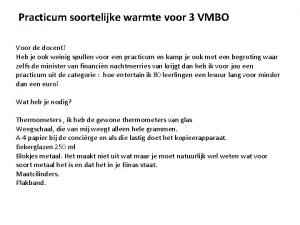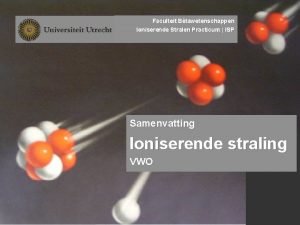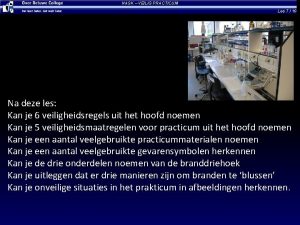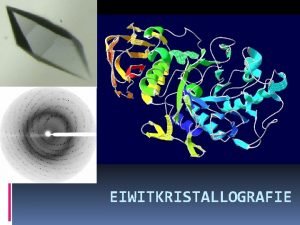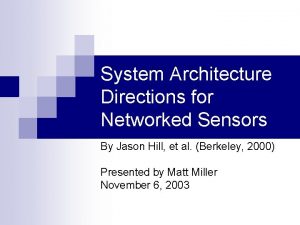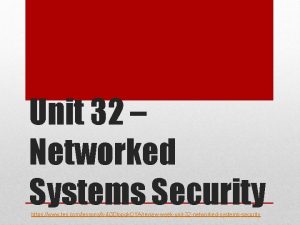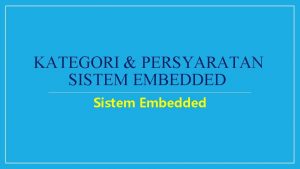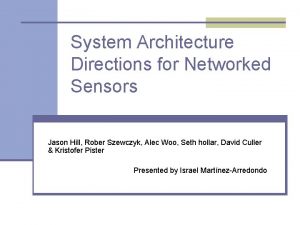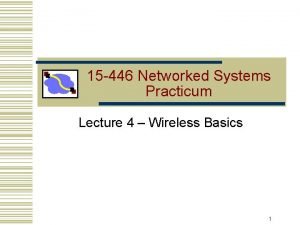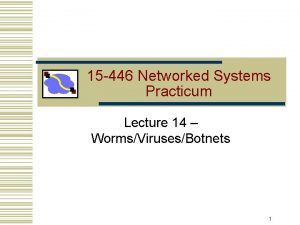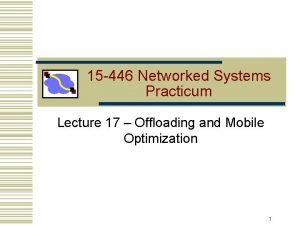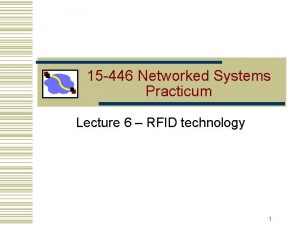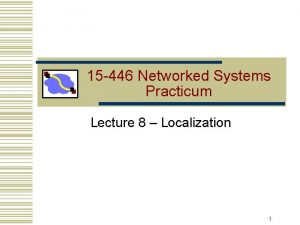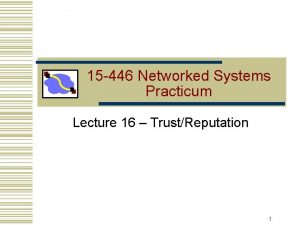15 446 Networked Systems Practicum Lecture 9 Next






















































- Slides: 54

15 -446 Networked Systems Practicum Lecture 9 – Next Gen Radio Technologies 1

Frequency Allocation == Isolation 2

A future allocation chart… Shared Spectrum Shared Spectrum Now how do we get to this!! 3

3 Ways To Isolate Signals • Frequency • Separate users by using different frequency bands • traditional method using analog filtering • Exploit wide bandwidths and DSP (60 Ghz) • Exploit higher frequencies • present CMOS technology allows use up to 100 GHz (60 GHz) • Space and Angle • Exploit the angular nature of the spatial channel • Multiple antennas (60 GHz) • Time • Sense interference and avoid (Cognitive Radio) 4

Back to our Frequency Allocation Chart If we use all 3 degrees of freedom then a chart like this really is meaningless 5

Outline • 60 Ghz • White Space • Software Defined Radios 6

The opportunity of higher frequencies 7 GHz of unused and unlicensed spectra 0 -3 GHz >> 99% of all wireless transmission 0 20 40 60 80 GHz 100 • Effectively no use above 5 GHz • Antenna arrays require only a small area • Absolutely necessary to get to gigabit/sec rates 7

Use of Higher Frequencies (e. g. 60 GHz) Conventional wisdom is that lower frequencies are better • Only line of sight operation is possible and can’t penetrate materials • The technology to process signals is expensive • As you go up in frequency there is an inherent “path loss” that reduces range Not True!!! 8

Material Penetration – actually not so bad 60 GHz 2. 5 GHz Pine board – ¾ ” 8 db 1. 5 d. B Clay Brick 9 d. B 2 d. B Glass with wire mesh 10. 2 d. B 7. 7 d. B Asphalt Shingle 1. 7 d. B 1. 5 d. B Plywood – ¾ ” Clear Glass 6. 4 d. B 3. 6 d. B What about Oxygen absorption? Atmosphere per 1. 5 d. B 0 d. B 100 m 9

Millimeter wave radios • Misconception: Implementing millimeter wave radios requires exotic materials • Conventional state-of-the-art digital CMOS can be used to implement integrated radios up to 100 GHz • Future technology scaling will allow even higher frequency operation (research is beginning into Terahertz operation) 10

Millimeter wave radios • Misconception: As you go up in frequency there is an inherent “path loss” that reduces range • This comes from only considering omnidirectional antennas which have a size that is inverse with carrier frequency • Solution is to keep area constant using directional antennas - then the received signal increases with frequency 11

Antenna fundamentals: Receive Antenna Energy Captured energy Low Gain Tx Antenna Area of sphere = 4 p r 2 Ar = Area of receive antenna Tx Rx Fraction of power received from an omnidirectional transmission = 12

Effective transmit antenna power Pt G t At = Area of transmitter Tx Rx • Maximum increase in power in direction of beam = (l = wavelength of carrier) • Effective maximum power as if it came from an omnidirectinal antenna = Pt Gt 13

The link budget with directional antennas Wasted energy Tx Captured energy In Area Ar Rx Receive power improves with frequency!! 22 d. B more gain at 60 GHz over 5 GHz if antenna size is kept constant (Compare to Friis “path loss” formula )

Millimeter wave radios • Misconception: Only line of sight transmission is possible • millimeter waves reflect like lower frequency waves, so adaptive directional antenna arrays can choose strongest signal • millimeter waves have higher material penetration loss, but this can be compensated for with the higher power and antenna gain 15

Non line of sight transmission • Phased Array Antennas • Power used more efficiently for better reception, longer distance, higher bandwidth • Dynamically steers beam to specific receiving station Transmitter in Source Si. BEAM Module 16

Angular isolation C A B • A transmits towards B with phased array • B only receives in direction of A • Transmitter C doesn’t interfere with B 17

Angular isolation C A B Interference between beamformed signals has to not only be in the same space, but also have the same angle 18

Another solution to aligned receivers C A B D • Start with link AB • Add aligned link CD • What do we do now…. 19

Use a reflection • Usually at least 2 -3 reflections • This is requiring more resolution in the phase shifters to control sidelobes 20

Outline • 60 Ghz • White Space • Software Defined Radios 21

60 GHz primer • 7 GHz of unlicensed spectrum @60 GHz • Forthcoming IEEE 802. 11 ad: 3 channels, bitrates to 6. 76 Gbps 2. 4 GHz • Challenge: • 60 GHz link has 55 d. B (312, 000 x) worse SNR 5 GHz than 2. 4 GHz link • Directionality is a fundamental mechanism GHz to enable 60 GHz 60 communication 22

Directionality is crucial Goodput (Gbps) 4 3 2 1 0 0 5 10 15 20 Distance (m) 23

60 GHz directional technology Phased Array Physical Antenna Compact (1 in 2) Electronic steering (µs) Fixed position 24

Directional 60 GHz links are not robust to blockage SNR (d. B) Beam Interrupted 30 15 0 Time (s) 25

Directional 60 GHz links are stable in a data center 24 h in Data Center 40 30 SNR (d. B) Beam Interrupted 15 20 0 0 Time (s) 26

A 60 GHz link in a data center 27

# Concurrent links per channel Flyways can be densely deployed Omni Wide Phocus Narrow • 160 racks, based on real DC topology • Draw random links until no more can be added • Ensure all links meet rate threshold • 12 -30 links per channel, depending on rate 28

Coordinating devices ✘ Leverage the wired backbone to sidestep issues of coordination 29

Predicting bitrate This is hard in multi-path environments Directionality alleviates multi-path: SNR lookup table [DIRC, SIGCOMM’ 09] Use SINR for interference 30

Outline • 60 Ghz • White Space • Software Defined Radios 31

Higher Frequency Broadcast TV Wi-Fi (ISM) 32

What are White Spaces? Wireless Mic TV 0 54 -90 170 -216 470 700 • 50 TV Channels MHz -60 ISM (Wi-Fi) 2400 2500 5180 5300 “White spaces” 7000 MHz • Each channel is 6 MHz wide dbm • FCC Regulations* TV Stations in America • Sense TV stations and Mics -100 MHz • Portable devices on channels - 51 Frequency 21700 470 MHz White Spaces are Unoccupied TV Channels 33

The Promise of White Spaces Wireless Mic TV 0 54 - 174 -216470 MHz 90 ISM (Wi-Fi) 2400 2500 700 5180 5300 7000 MHz Up to 3 x of 802. 11 g More Spectrum Longer Range at least 3 - 4 x of Wi-Fi 34

Cognitive Radios • Basic idea • Exploit the time degree of freedom by sensing if a signal is present • Then take steps to assure there isn’t interference • This is quite restricted, others use a more expanded definition 35

A Cognitive Radio using Time and Frequency PU PU 3 Power 1 PU 2 PU 4 • • • Frequency Sense the spectral environment over a wide bandwidth Transmit in “White Space” Detect if primary user appears Move to new white space Adapt bandwidth and power levels to meet QOS requirements 36

White Spaces Spectrum Availability Fraction of Spectrum Segments 0. 8 Differences from ISM(Wi-Fi) Urban 0. 7 0. 6 Suburban 0. 5 Rural Fragmentation Variable channel widths 0. 4 0. 3 0. 2 1 2 0. 13 4 5 0 1 1 2 3 4 5 6 # Contiguous Channels >6 Each TV Channel is 6 MHz wide Spectrum is. Use Fragmented multiple channels for more bandwidth 37

White Spaces Spectrum Availability Differences from ISM(Wi-Fi) Fragmentation Variable channel widths Spatial Variation Cannot assume same channel free everywhere 1 2 3 4 5 TV Tower Location impacts spectrum availability Spectrum exhibits spatial variation 38

White Spaces Spectrum Availability Differences from ISM(Wi-Fi) Fragmentation Variable channel widths Spatial Variation Cannot assume same channel free everywhere 1 2 3 4 5 Temporal Variation Same Channel will not always be free Any connection can be disrupted any time Incumbents appear/disappear over time Must reconfigure after disconnection 39

Channel Assignment in Wi-Fi 1 6 11 Fixed Width Channels 1 6 11 Optimize which channel to use 40

Spectrum Assignment in White. Fi Spectrum Assignment Problem Maximize Throughput Goal Include 1 2 3 4 5 Assign Spectrum at clients 1 2 3 4 5 Center Channel & Width Fragmentation Optimize for both, center channel and width Spatial Variation BS must use channel iff free at client 41

Accounting for Spatial Variation 1 2 3 4 5 1 2 3 4 5 = 1 2 3 4 5 42

Intuition Use widest possible channel BS But Limited by most busy channel 1 2 3 4 5 § Carrier Sense Across All Channels § All channels must be free §ρBS(2 and 3 are free) = ρBS(2 is free) x ρBS(3 is free) Tradeoff between wider channel widths and opportunity to transmit on each channel 43

Discovering a Base Station 1 2 3 4 5 Discovery Time = (B x W) Howwedoes the new discover Can optimize thisclient discovery time? channels used by the BS? Fragmentation Try different center channel and widths BS and Clients must use same channels 44

SIFT, by example 10 5 MHz SIFT Does not decode packets Pattern match in time domain Amplitude ADC Data SIFT ACK SIFS Time 45

White Space Availability Reclaiming the White Spaces • Spectrum availability is critical to adoption and goals Goal: “[to] make a significant amount of spectrum available Rescuefor. White Space by Enabling Mic Coexistence new and innovative products and services” – FCC 08 -260 • Spectrum is most critical in populated areas • Measure spectrum availability in top 30 U. S. cities [1] single channel Number of Analog TV Broadcasts Decreasing Over Time 53% of cities cannot support single 802. 11 2 Reserved Channels channel in the white spaces [1] Geo-location database: http: //whitespaces. msresearch. us/ Losing a Significant Amount of White Space to Mic Rules 46

Analog Microphone Background • One-way communication: receiver never transmits – Mic always transmitting (even idle) • Signal Components: Wireless Mic FM Modulated Audio Signal Mic Receiver Used By Mic Receiver to Detect Low Signal and Mute 47

The Challenge of Suppression Stronger WSD More Suppression `Perfect Actual Suppression’ Suppression would sharp Leakshave Power in toedge the Band Weaker Mic More Suppression 48

Information Needed to Suppress • Two components needed at WSD to suppress properly: 1. WSD Interference Power at the Mic Receiver White Space Device (WSD) Mic Receiver Wireless Mic 2. Mic Signal Power at Mic Receiver 49

SEISMIC System Overview • Implements closed-loop design to avoid vacating channel: • Measurement: Mic. Protector measures key components at receiver • Feedback: “Strobe” signal to notify WSD of impending disruption • Analysis / Adaptation: SEISMIC protocol to adapt frequency Feedback Mic. Protector White Space Device Mic Receiver Mic 52

Feedback: Strobes • Mic. Protector needs to convey information to WSD • Strobe is similar to Morse-codes and on/off-keying (OOK) • Strobe signals convey: • (1) impending disruption, (2) required bandwidth, (3) center frequency Amplitude • Allows us to convey necessary information without complex protocol (e. g. , 802. 11) Frequency 53

Adaptation / Analysis: SEISMIC Protocol • WSD: sends probe packets with increasing power (exploit capture) • Mic. Protector: notifies of impending disruption, using strobes Control Band Amplitude Control Band Protection Threshold Interference Level 25 KHz Frequency 25 KHz 54

Back to our Frequency Allocation Chart If we use all 3 degrees of freedom then a chart like this really is meaningless 55

A future allocation chart… Shared Spectrum Shared Spectrum Now how do we get to this!! 56
 X.next = x.next.next
X.next = x.next.next Networked systems security
Networked systems security Jarecki uci
Jarecki uci O homem que calculava malba tahan
O homem que calculava malba tahan Hino 446
Hino 446 Sdlaw login
Sdlaw login Literal rule in law
Literal rule in law Aids to statutory interpretation
Aids to statutory interpretation 446 pessoas
446 pessoas Troop 446 pearland
Troop 446 pearland 01:640:244 lecture notes - lecture 15: plat, idah, farad
01:640:244 lecture notes - lecture 15: plat, idah, farad Walden university nursing
Walden university nursing Ethical and legal issues involved in practicum
Ethical and legal issues involved in practicum Pas fifsw
Pas fifsw Practicum soortelijke warmte
Practicum soortelijke warmte Chamberlain dnp curriculum
Chamberlain dnp curriculum Cel practicum
Cel practicum Marketing practicum
Marketing practicum Hefa ii
Hefa ii Ioniserende straling practicum
Ioniserende straling practicum Gaasje nask
Gaasje nask Indampschaaltje
Indampschaaltje Networked insurance agents
Networked insurance agents Distributed os definition
Distributed os definition System architecture directions for networked sensors
System architecture directions for networked sensors Unit 32 networked system security
Unit 32 networked system security Fully networked vehicle
Fully networked vehicle Networked outdoor lighting
Networked outdoor lighting Kategori kategori dari embedded system
Kategori kategori dari embedded system System architecture directions for networked sensors
System architecture directions for networked sensors Networked digital library of theses and dissertations ndltd
Networked digital library of theses and dissertations ndltd Networked sensor array
Networked sensor array Operating system lecture notes
Operating system lecture notes Articulators
Articulators Lecture sound systems
Lecture sound systems Decision support systems and intelligent systems
Decision support systems and intelligent systems Principles of complex systems for systems engineering
Principles of complex systems for systems engineering Embedded systems vs cyber physical systems
Embedded systems vs cyber physical systems Engineering elegant systems: theory of systems engineering
Engineering elegant systems: theory of systems engineering Project procurement management lecture notes
Project procurement management lecture notes Lecture about sport
Lecture about sport Healthy lifestyle wrap up lecture
Healthy lifestyle wrap up lecture Makeup lecture meaning
Makeup lecture meaning Meaning of this
Meaning of this Randy pausch the last lecture summary
Randy pausch the last lecture summary Tensorflow lecture
Tensorflow lecture Theology proper lecture notes
Theology proper lecture notes Strategic management lecture
Strategic management lecture Geology lecture series
Geology lecture series Social psychology lecture
Social psychology lecture In text citation for a lecture
In text citation for a lecture Lecture notes on public sector accounting-ghana pdf
Lecture notes on public sector accounting-ghana pdf Software project management lecture notes
Software project management lecture notes Eurocode 2 lap length table
Eurocode 2 lap length table Electricity and magnetism lecture notes
Electricity and magnetism lecture notes






